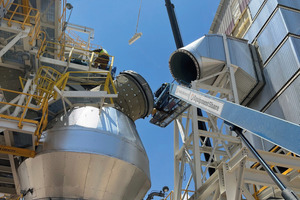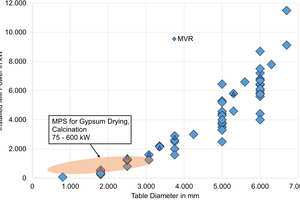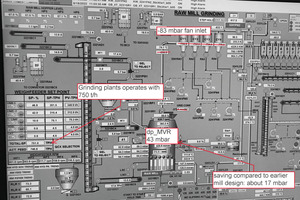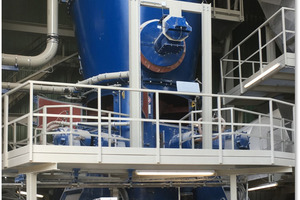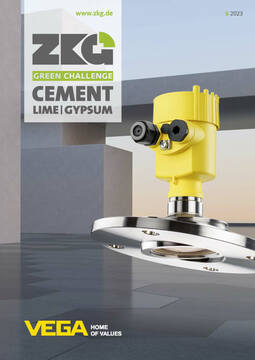Challenges for a versatile grinding system in a green future and matching solutions
The performance of a vertical roller mill is defined by a required throughput at a required fineness paired with a low specific thermal and electric energy consumption. The combination of three process steps in one system – drying, grinding, separating – makes the vertical roller mill very versatile in regard to handling dry and moist feed materials, and grinding these to very high fineness, creating the product properties required by the different market areas.
1 Introduction
As cement is the most widely consumed building product in the world, a huge volume is produced. Cement production is responsible for about 8% of man-made CO2-emissions [1]. The International Energy Agency (IEA) has highlighted four principal CO2 reduction levers. Key strategies to cut carbon emissions in cement production include improving energy efficiency, switching to lower-carbon fuels, promoting material efficiency (to reduce the clinker-to-cement ratio and total demand) and advancing process and technology innovations such as CCS [2].
Reducing the clinker proportion in cement is said to be by far the most effective measure. The use of Supplementary Cementitious Materials (SCMs) to replace clinker in cement is only part of the picture but gives a good indication in order to evaluate the effectiveness of composite cements regarding their carbon footprint. For the evaluation of energy use and CO2 emissions, the proportion of SCMs must be considered, but also likewise does the product fineness of the composite cement, as it is impacted by the reactivity of the SCM in use. As not all SCMs give a sufficient reactivity at lower Blaine, the product fineness overall must be increased under certain conditions.
Not only use of SCM is an effective measure to reduce the carbon footprint, improving energy efficiency is also a key factor for grinding plants. In cement production more than 60% of electricity is used for grinding of raw material and cement. With this huge amount it seems mandatorily that energy efficient technologies should be used.
State-of-the-art grinding technologies as vertical roller mills can provide up to 70% electricity savings compared to ball mill systems [2]. Vertical roller mills are in operation in many other industries such as lime, gypsum, industrial minerals. In all installations the performance of a vertical roller mill in regard to energy efficiency and sustainability is the main factor for success in a green future.
2 Development and performance
For all applications, the required product quality is the most important target together with energy efficiency and availability of the system. Therefore, some areas in general need special attention: feed uniformity, metal detection and extraction, and preventive maintenance to name just a few. The levers to pull for a well performing vertical roller mill are operational parameters such as table speed, gas flow, working pressure, and mechanical adjustments such as dam ring height and covering the nozzle ring.
Gebr. Pfeiffer sold its first vertical roller mill in the 1950’s. The MPS mills with three rollers and a molded grinding table is in operation in several thousand installations. With the introduction of the MVR mill to the market in 2010 a new concept was available for very high throughput rates. MVR mills have cylindrical rollers and a flat grinding table. Each roller has its own hydraulic suspension and roller arm, some rollers can be removed for maintenance while keeping the others under a partial load. This system is known as ‘active redundancy’. The MVR duty series is available for very small capacities of several tons per hour up to 1000 t/h for cement raw material or materials with similar properties. For applications such as gypsum drying/grinding and gypsum calcination, solid fuel grinding the MPS duty series is especially adapted. Limestone e.g., can be ground both in MPS mills and MVR mills. The selection depends on the required capacity and overall evaluation of the project. Figure 1 shows the installed power per table diameter for MPS and MVR mills with the focus on the complete range of MVR mills and on gypsum calcining for MPS mills.
Design improvements have been traditionally approached from three sides in the past. The process design department with a test center and lab is working out the parameters for ideal process design; the experience coming from the field is evaluated, and the mechanical design itself with proper analysis of stress and strain. This approach is relying on a lot of experience from testing and industrial operation. Computer-aided tools have cut down the R&D-time massively. By using two-phase CFD a lot of modifications have been implemented for reduction of pressure loss in the system, e.g., modification in the classifier and in the hot gas inlet duct.
The mill pressure drop of a cement raw material mill of the type MVR 6000 R-6 has been reduced from 60 mbar down to 43 mbar. This difference of 17 mbar is pursuant to the pressure at fan inlet and gives with a reduction of 1.5 to 2.0 kWh/t a huge potential for reduced OPEX. This MVR 6000 R-6 is producing 750 t/h cement raw material with a fineness of 18% R90μm. Figure 2 shows the screenshot of the MVR 6000 R-6 operational overview from the CCR. The figures for mill pressure drop and pressure at fan inlet are enlarged.
Continuous improvement is done in the main areas of sustainability, efficiency, and digitalization. This product development is oriented to the needs of the clients where the mill is not the only focus but the complete plant.
3 Digitalization and Artificial Intelligence (AI)
Industry 4.0 is also a driver for clients to cover operational support. This feature is offered as digital ‘modules’ where Gebr. Pfeiffer focuses on the maintenance and enhancement of operations at the moment. One of these digital modules is GPlink which stores sensor data for data analysis and enables 24/7 access to data from mobile devices. When transmitted to the company’s service team a solid basis for support and rapid and targeted assistance is given.
GPpro facilitates the Advanced Maintenance System with scheduled maintenance and is adapted for actual needs. This system includes a wider range of sensors as well as data analysis tools and reports partly with the help of artificial intelligence. Reacting to the changing requirements this product is developed further. The modular structure offers functions in the areas of e.g., preventative maintenance, protection of the mill, reduction of water consumption. The module ‘dynamic water injection’ enables the control of the injected water depending on vibrations in combination with working pressure and resulting bed height. The GPpro system has helped during the pandemic to bring plants into operation, where commissioning was assisted from a distance with online meetings. By providing additional images and footage from the plant sites the support could be targeted to specific topics to reduce commissioning time.
Developments in Artificial Intelligence (AI) are in progress to optimize mill operations. Skilled human operators can set several operating parameters and overlook the interaction of these. With the support of AI a huge number of parameters and parameter sets is examined and determines the ideal setting value for the application requirements, e.g. improvement of specific power consumption, increasing the capacity, etc. The results with industrial mills are very promising.
4 Supplementary Cementitious Materials (SCMs)
SCMs or clinker replacement materials influence grindability, operational behavior, and reactivity.
Calcined clays are one promising material for future applications as SCMs. The number of industrial production sites is increasing, but information available on the impact of grinding on its properties is currently limited. The process of grinding has significant effect on the reactivity and performance of SCMs [3], but specific procedures for the grinding of calcined clays have not yet been established [4]. Several influences originating from the grinding of calcined clays are known based on laboratory tests. Mineralogical composition especially of common clays (e.g., content of clays and quartz) will impact the particle size distribution and may lead to an enrichment of calcined clay particles in the finer fraction, but the quartz will also promote a deagglomeration effect. The fineness of calcined clays can significantly affect compressive strength of concretes made with blended cements. The reactivity (determined by using isothermal calorimetry that gives a rapid indication of calcined clay reactivity (R3-Test [5]) and by solubility of Si and Al ions) depends on product fineness and grinding parameters. Increasing the fineness of a calcined clay from 7600-12500 cm2/g results in 15% better reactivity. The activity index, determined as compressive strength according to DIN EN 196, reaches up to 90% for mixtures with a replacement level of 40% calcined clay after 28 days.
Reactivity indices of SCMs are very different and properties such as feed moisture and granulometry occur in a wide range. Therefore, a fine adjustment of the feed material properties and the target fineness of the finished product needs to be done. When it comes to composite cements, the versatility of modular vertical roller mills is impressive. These mills are very flexible for the grinding of different materials, such as: clinker, limestone, GBFS, pozzolana, fly ash, bottom ash, calcined clay, etc., with a wide range of properties. When moist materials are included in the feed mix, a heated rotary lock will be installed. When dry and already quite fine materials are included, an additional feeding point is provided at the classifier housing. All the listed features apply as well to all industries where MPS and MVR mills are in operation.
5 Examples for versatility of MPS and MVR systems
5.1 Grit extraction
MPS and MVR mills can be equipped with an additional screw conveyor in the grit cone or below the grit cone for extraction of coarse material. With this arrangement a second product can be produced, e.g., limestone meal with 20% residue on 45 μm and grits within a range between 0.1 mm and 1.2 mm.
Figure 3 shows an MVR 1800 R-4 for limestone grinding where the grit extraction is installed to produce a fine product and a coarser product in one step. This mill is capable of grinding very fine limestone with 0.1% residue on 20 μm as well.
The grit extraction can also be applied for grinding of materials for ceramic production when the removement of impurities is required.
5.2 MPS GC mills for grinding, drying and calcining
The MPS GC mill is used to process natural gypsum and FGD gypsum and recycled material. To generate the required energy for the drying and calcining for the gypsum, the mill has to be operated at a high temperature. The required gas temperature at the classifier outlet is around 160 °C and the hot gas inlet is up to 600 °C. All areas exposed to high temperatures are designed for this special application regarding mechanical and thermal stress. The grinding bowl is equipped with heat insulation and a heat shield in the hot gas area. The mill operation can be adjusted easily for the handling of the different types of gypsum. The mill motor is equipped with a VFD to operate at different table speeds. FGD gypsum requires lower table speed and lower specific grinding force than natural gypsum. Recycled gypsum is contaminated with concrete, bricks, and metal parts which need to be removed before being fed to the mill. The mill can switch between different feed materials during operation by adjusting the grinding pressure, table speed and classifier speed.
The portfolio for feed mixtures is quite big with usage of 100% natural gypsum, 100% FGD gypsum, blends of the two, blends of recycled gypsum together with natural or FGD and blends of all three materials.
With the trend towards more recycled gypsum content and disappearance of FGD gypsum – at least in Europe – the challenge for appropriate grinding is clearly required. This combined with the trend towards better control of the particle size distribution and reduction of water to plaster ratio gives many opportunities for process refinement. The capacity range is between 10 to 100 t/h, with mills for higher throughputs available in the duty series. The lead picture shows a partly erected MPS GC mill.
6 Outlook
Reducing the carbon footprint is a challenging situation for all industries. With a versatile system like the MVR and MPS mill different tasks to reduce the CO2 emissions can be targeted. The performance of these mills is defined by a required throughput at a required fineness paired with a low specific thermal and electric energy consumption. The combination of three process steps in one system – drying, grinding, separating – makes the vertical roller mill very versatile in regard to handling dry and moist feed materials, and grinding these to very high fineness, creating the product properties required by the different market areas. Grinding of different SCMs is already realized in many installations. Increasing the energy efficiency is focused by R&D topics such as reduction of pressure drop of the complete system; the use of CFD with 2-phase simulation helps not only for the mill but also for the plant with filter, fan and ducting. Digitalization is supporting and enhancing operational behavior and preventive maintenance. With the support of AI the ideal setting values for application requirements can be selected specifically.
A huge range of capacities can be covered by MVR mills with the modular technology. Special applications for e.g., gypsum calcining and solid fuels have been realized for many decades with adapted MPS mills.
A supplier of energy efficient grinding equipment has to meet all requirements regarding product quality, capacity, energy efficiency, versatility for the product portfolio, reliability and availability of the plant and sustainability together with giving reliable guarantees. Increasing the performance of the system is supported by R&D, the implementation of modifications has to be reliable and proven to ensure a trouble-free operation in combination with a quick time to market.

